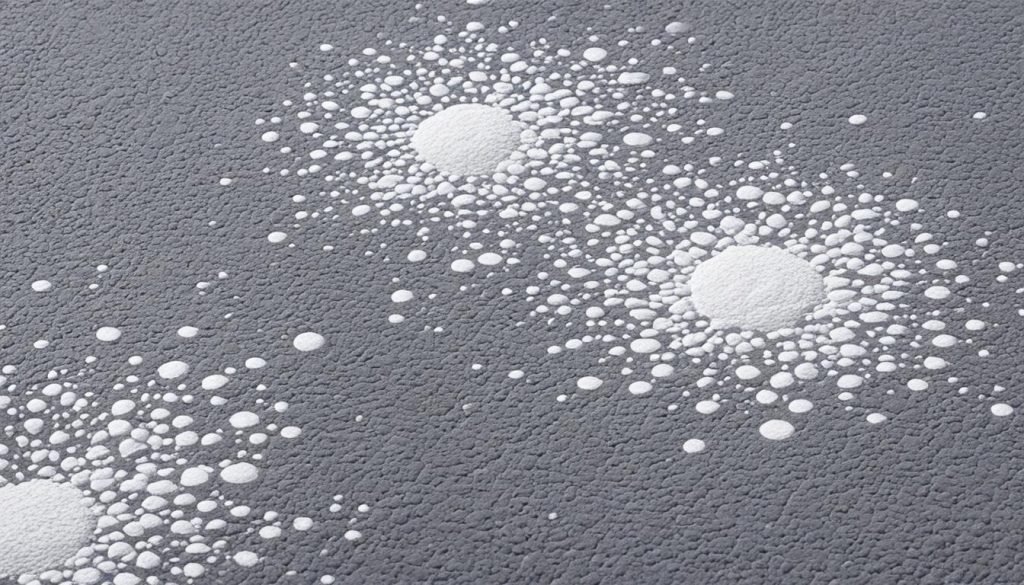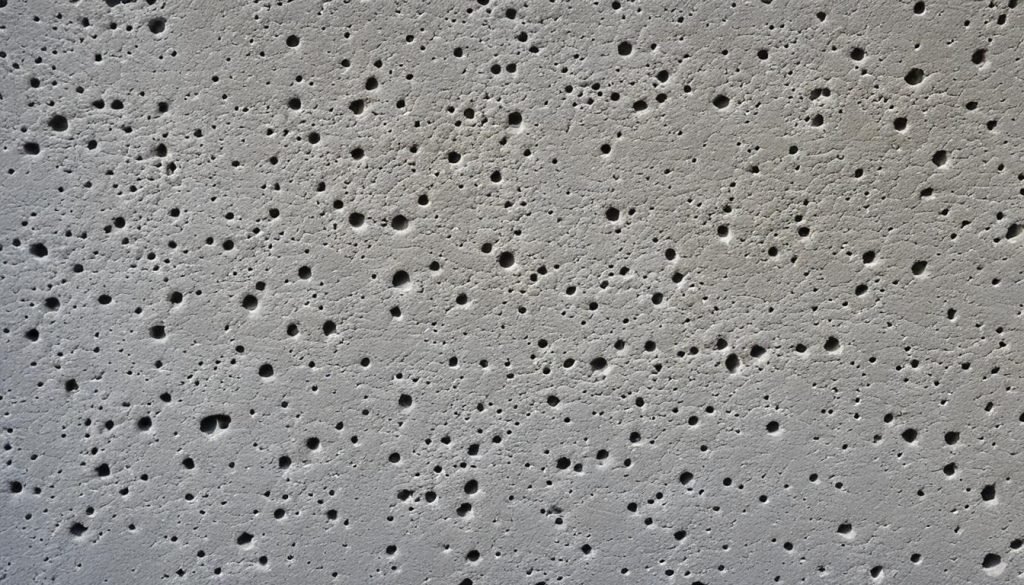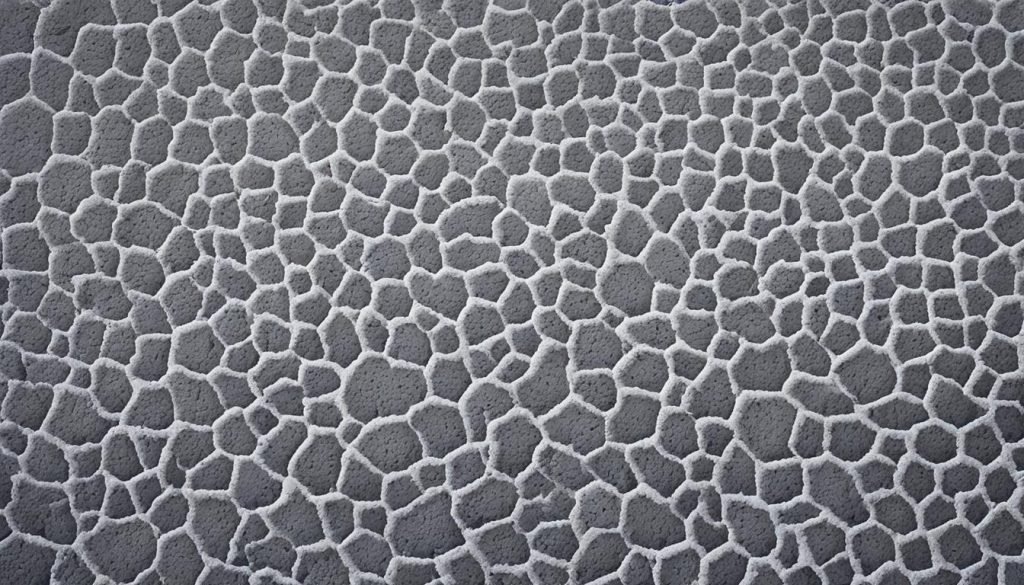If you’ve noticed white or off-white stains on your concrete surfaces, you may be dealing with efflorescence. Efflorescence occurs when soluble salts and other materials rise to the surface of concrete through capillary voids, leaving behind unsightly residue. However, there are effective methods to remove this white residue and restore the clean appearance of your concrete. If you’re in need of help, Choose a seasoned concrete contractor in Toowoomba for guaranteed quality. Enhance your construction skills by exploring this comprehensive guide on How to Build a Deck on Concrete Slab: Step-by-Step Guide. Gain valuable insights and step-by-step guidance for success in building a deck on a concrete slab.
When it comes to concrete cleaning methods, it’s important to understand the causes of efflorescence. Factors such as soluble salts in the concrete, moisture, and temperature changes can trigger the formation of white stains on concrete surfaces. By addressing these factors and implementing prevention techniques, you can minimize the occurrence of efflorescence.
Efflorescence can be avoided by using high-quality ingredients in the concrete mix, incorporating efflorescence-controlling admixtures, and managing the moisture content. Additionally, proper curing techniques and drainage systems can help prevent the migration of moisture and salts to the concrete surface.
If efflorescence does appear on your concrete, it’s vital to know how to remove it effectively. Specialized chemical treatments designed to dissolve and remove the soluble salts can be used. However, it’s important to exercise caution and wear protective gear when working with these products.
While efflorescence is generally a cosmetic issue that doesn’t affect the structural integrity of the concrete, severe cases may indicate underlying durability issues. Therefore, it’s advisable to consult a professional engineer if you suspect any structural concerns.
To prevent the formation of white residue on concrete, it’s crucial to take preventive measures. These include using high-quality materials, controlling water content in the mix, proper curing techniques, and implementing effective drainage systems. Applying coatings or sealants to the concrete surface can also provide added protection.
In case your concrete has already been stained by efflorescence or other substances, there are various techniques you can use to remove the stains. Washing the surface with clear water, applying acid solutions, or using commercial concrete cleaners can help restore the cleanliness of the concrete.
Key Takeaways:
- Effflorescence is a common issue that leaves white stains on concrete surfaces.
- Preventing efflorescence involves controlling soluble salts, moisture, and migrating channels.
- Efflorescence can be removed using specialized chemical treatments.
- Efflorescence is often a cosmetic problem but severe cases may indicate underlying durability issues.
- Maintaining and protecting the concrete surface can prevent the formation of white residue.
What Causes Efflorescence on Concrete?
Efflorescence is a common issue that can occur on concrete surfaces, leaving behind white or off-white stains. It is caused by soluble salts and other materials coming to the surface through capillary voids in the concrete. So, what exactly causes efflorescence on concrete?
The primary causes of efflorescence are:
- Water-soluble salts in the concrete
- Moisture in the concrete
The water-soluble salts can originate from various sources like cement, aggregates, water, or admixtures used in the concrete. When moisture is present in the concrete, whether it’s due to temperature changes, condensation, rain, or excessive water in the mix, the salts are triggered to crystallize and form the characteristic white or off-white staining on the concrete surface.
To give you a clearer understanding, here’s a simplified visual representation:
| Sources of Salts | Moisture in Concrete | Efflorescence |
|---|---|---|
| Cement, aggregates, water, admixtures | Temperature changes, condensation, rain, excessive water in the mix | White or off-white staining on concrete surface |
Efflorescence is a reaction between the salts, moisture, and the concrete surface, resulting in the visible residue. It’s important to understand these causes in order to effectively prevent and address efflorescence on concrete surfaces.
In the next section, we will explore methods to avoid and prevent efflorescence from occurring.
How Can Efflorescence be Avoided/Prevented?
Efflorescence, the white residue that appears on concrete surfaces, can be minimized or even prevented by addressing the three contributing factors: soluble salts, moisture, and migrating channels. By taking proactive measures, both concrete and mortar manufacturers as well as contractors can effectively manage efflorescence and maintain the integrity of the concrete.
To prevent the formation of efflorescence, concrete and mortar manufacturers should use high-quality ingredients and incorporate efflorescence-controlling admixtures. Additionally, the addition of pozzolans and other lime-consuming materials can help alleviate the issue. These measures ensure that the soluble salts, which contribute to efflorescence, are minimized in the concrete mixture.
Contractors, on the other hand, play a crucial role in managing moisture and minimizing migrating channels. It is essential that they utilize the appropriate amount of mixing water during the concrete placement process. By controlling the water content, contractors can significantly reduce the permeability and water absorption of the concrete, mitigating the conditions favorable for efflorescence formation. Proper curing techniques should also be employed to further enhance the concrete’s resistance to efflorescence.
Moreover, it is important to implement proper drainage systems and take measures to protect against moisture intrusion. Adequate drainage helps minimize the migration of moisture and soluble salts to the concrete surface, reducing the likelihood of efflorescence. Moisture management techniques such as waterproofing or applying vapor barriers can be used to prevent excess moisture from seeping into the concrete.
By effectively controlling the levels of soluble salts, managing moisture, and minimizing migrating channels, the occurrence of efflorescence can be prevented or significantly reduced, ensuring a durable and aesthetically pleasing concrete surface.
How Can Efflorescence be Removed?
If you’re dealing with efflorescence on your concrete surface, there are effective methods to remove these unsightly white deposits. Specialized efflorescence cleaners can dissolve and eliminate the soluble salts, restoring the appearance of your concrete. One such product is Quikrete Efflorescence and Rust Remover, which is specifically designed to tackle efflorescence issues.
Here’s a step-by-step guide on how to remove efflorescence from concrete:
- Identify the affected areas: Inspect your concrete for areas with white stains or deposits.
- Prepare the surface: Ensure that the concrete surface is clean and free of debris.
- Apply the efflorescence cleaner: Follow the manufacturer’s instructions and apply the efflorescence cleaner, such as Quikrete Efflorescence and Rust Remover, to the affected areas. Make sure to wear protective gear like gloves and goggles.
- Scrub or rinse: Depending on the product’s instructions, scrub the treated areas with a brush or rinse with water to remove the dissolved efflorescence.
- Repeat if necessary: For severe cases or stubborn deposits, you may need to repeat the process or apply multiple treatments.
It’s important to note that sandblasting is not recommended for efflorescence removal as it can damage the concrete surface. Instead, opt for specialized cleaners that are designed for this specific purpose. Always follow the instructions provided by the product manufacturer and take proper safety precautions when working with efflorescence removal products.
Removing efflorescence from concrete can restore the appearance of your surfaces and improve their overall aesthetic appeal. By following the proper removal techniques and using effective cleaners, you can effectively eliminate white deposits and maintain a clean and pristine concrete surface.
Is Efflorescence a Structural Problem or Cosmetic?

Efflorescence is a common issue that can occur on concrete surfaces, leaving behind white or off-white stains. The question arises: is efflorescence merely a cosmetic concern or does it indicate a structural problem?
In most cases, efflorescence is purely cosmetic and does not affect the structural integrity of the concrete. It is a result of soluble salts and moisture coming to the surface through capillary voids in the concrete.
Efflorescence does not indicate any underlying structural issues. It is more of an aesthetic nuisance than a threat to the concrete’s stability. The appearance of white residue on the surface can be unsightly, but it doesn’t pose a risk to the structural integrity of the concrete.
However, there are rare cases where severe efflorescence accompanied by scaling, deterioration, or structural failure may indicate other durability issues that need to be addressed by a professional engineer. These cases require thorough investigation and assessment to determine the extent of the problem and develop appropriate remedial measures.
When dealing with efflorescence, it is essential to differentiate between cosmetic efflorescence and any potential structural concerns. By understanding the nature of efflorescence and its impact, you can make informed decisions about its treatment and prevention.
To better understand cosmetic efflorescence, it’s helpful to consider some examples:
“The efflorescence on the concrete patio was purely cosmetic, causing no structural issues. After cleaning the surface, the patio regained its original appearance without any compromise to its stability.”
| Efflorescence | Structural Problem |
|---|---|
| Purely cosmetic | No |
| Caused by soluble salts and moisture | No |
| Affects the concrete’s appearance | No |
| Rare cases of severe efflorescence indicate other durability issues | Yes |
| Does not compromise structural integrity | No |
Will Efflorescence Go Away on Its Own?

Efflorescence on concrete surfaces is a persistent issue that typically does not disappear on its own. However, in certain situations, lighter efflorescence may gradually fade or blend in with its surroundings over time due to natural aging and weathering processes. In such cases, specific treatments or cleanings may not be necessary.
It’s important to note that even if efflorescence seems to fade, it can still reappear if the underlying causes are not addressed. Efflorescence, often caused by moisture or soluble salts, can continue to accumulate and resurface on the concrete if preventive measures are not taken.
To visually illustrate this concept, refer to the following table:
| Efflorescence Intensity | Appearance | Natural Removal |
|---|---|---|
| Light | Fades or blends with surroundings | May naturally fade over time |
| Moderate | Visible and distinct white residues | Requires treatment and cleaning methods |
| Heavy | Thick and noticeable deposits | Demands thorough and intensive removal procedures |
“Efflorescence on concrete surfaces may fade over time, but addressing the underlying causes is vital to prevent its reappearance.”
Tips to Prevent White Residue on Concrete
To maintain the pristine appearance of your concrete and prevent the formation of white residue, it is crucial to implement preventive measures. By following these concrete maintenance tips and efflorescence prevention techniques, you can ensure the long-term protection of your concrete surface.
1. Use High-Quality Materials
When undertaking any concrete projects, it is essential to use high-quality materials. Opt for reputable brands and suppliers that offer reliable concrete products. Using inferior materials can increase the risk of efflorescence formation.
2. Control Water Content in the Mix
Properly controlling the water content in the concrete mix is crucial in preventing the occurrence of white residue. Aim for the recommended water-to-cement ratio to avoid excessive moisture, which can contribute to efflorescence.
3. Implement Proper Curing Techniques
Implementing proper curing techniques is vital to reduce the permeability and water absorption of the concrete. This helps minimize the migration of moisture and salts to the surface, preventing the formation of white stains. Follow the recommended curing time and methods specified by the concrete manufacturer.
4. Implement Effective Drainage Systems
Ensuring effective drainage systems around concrete structures is important in managing moisture. Proper drainage prevents water from accumulating near the concrete surface, reducing the likelihood of efflorescence formation. Consider incorporating slopes, gutters, and adequate runoff systems to redirect water away from the concrete.
5. Apply Coatings or Sealants
Applying coatings or sealants to the concrete surface can provide an additional layer of protection against moisture infiltration. These products act as a barrier, minimizing the risk of efflorescence and enhancing the longevity of the concrete. Choose high-quality coatings or sealants designed specifically for concrete surfaces.
6. Regular Maintenance
Regular maintenance is essential to prevent the accumulation of dirt, dust, and other pollutants on the concrete surface. Cleaning the concrete with mild detergents and periodic sealing can help maintain its appearance and protect it from potential efflorescence.
Efflorescence Prevention Techniques at a Glance
| Prevention Techniques | Benefits |
|---|---|
| Use high-quality materials | Reduces risk of efflorescence formation |
| Control water content in the mix | Prevents excessive moisture in the concrete |
| Implement proper curing techniques | Reduces permeability and water absorption |
| Implement effective drainage systems | Manages moisture and prevents water accumulation |
| Apply coatings or sealants | Protects concrete surface from moisture infiltration |
| Regular maintenance | Preserves the appearance and lifespan of the concrete |
By implementing these concrete maintenance tips and efflorescence prevention techniques, you can safeguard your concrete surface from the unsightly white residue. Taking proactive measures and carrying out regular maintenance will help protect the integrity and appearance of your concrete for years to come.
Concrete Stain Removal Techniques
If your concrete has become stained by efflorescence or other substances, there are effective techniques you can use to remove the stains and restore the surface. Here are some recommended methods:
1. Washing and Scrubbing
Start by washing the stained surface with clear water to remove any loose dirt or debris. Then, use a scrub brush or a stiff bristle broom to scrub the area thoroughly. This can help loosen and lift the stain from the concrete surface.
2. Acid Solutions
Another option is to apply acid solutions like vinegar or citric acid to the stained area. Dilute the acid with water according to the manufacturer’s instructions, then apply the solution to the stain. Allow it to sit for a few minutes, and then scrub the area with a brush. Be sure to wear protective gloves and eyewear when handling acid solutions.
3. Commercial Concrete Cleaners
There are also various commercial concrete cleaners available that are specifically designed for stain removal. These cleaners are formulated to penetrate the concrete and break down the stain. Follow the instructions on the product label for the best results and safety precautions.
It is important to note that different stains may require different cleaning methods. Always start with the mildest cleaning solution and gradually increase the strength if necessary. Test the cleaning solution in a small, inconspicuous area first to ensure it does not cause any damage to the concrete surface.
Proper sealing and maintenance can also help prevent future staining and make cleaning easier. Applying a concrete sealer can provide a protective barrier against stains and make it easier to clean the surface in the future. Regular maintenance, such as sweeping or pressure washing, can help remove dirt and prevent stains from becoming embedded in the concrete.
| Stain Removal Method | Description |
|---|---|
| Washing and Scrubbing | Using water and a scrub brush to physically remove stains from the concrete surface |
| Acid Solutions | Applying vinegar or citric acid diluted with water to dissolve and remove stains |
| Commercial Concrete Cleaners | Using specialized cleaners designed for concrete stain removal |
By utilizing these concrete stain removal techniques and taking preventive measures, you can keep your concrete surfaces clean and restored. Remember to always follow safety guidelines and consider consulting professionals for stubborn or extensive stains.
Conclusion
Efflorescence, the white residue that can appear on concrete surfaces, can be effectively managed and removed using various methods. By understanding the causes and implementing prevention techniques, you can maintain the appearance and integrity of your concrete.
Regular cleaning, proper drainage, and the use of high-quality materials are essential in preventing efflorescence from occurring. Consistent maintenance practices, such as regular cleaning and sealing, can prolong the lifespan and enhance the overall look of your concrete.
If efflorescence does appear, there are specialized cleaners and techniques available to remove the stains. It is important to follow the instructions provided by the product manufacturers and take necessary precautions when working with these materials. Additionally, addressing the underlying causes, such as moisture or soluble salts, is crucial to prevent efflorescence from reoccurring.
To ensure a clean and pristine concrete surface, it is recommended to seek professional concrete cleaning and maintenance services. Contact Toowoomba Concreters at (07) 4520 1314 for expert assistance with concrete cleaning and maintenance needs.
FAQ
What causes efflorescence on concrete?
Efflorescence occurs when water-soluble salts in the concrete come to the surface through capillary voids. These salts can come from the cement, aggregates, water, or admixtures used in the concrete. Moisture in the concrete, such as from temperature changes, condensation, rain, or too much water in the mix, can trigger the formation of efflorescence. The salts crystallize and result in the white or off-white staining on the concrete.
How can efflorescence be avoided/prevented?
Efflorescence can be minimized or prevented by controlling the three contributing factors – soluble salts, moisture, and migrating channels. Concrete and mortar manufacturers can use high-quality ingredients, add pozzolans and other lime-consuming materials, and incorporate efflorescence-controlling admixtures. Contractors should use the proper amount of mixing water and proper curing techniques to lower the permeability and water absorption of the concrete. Proper drainage systems and protection against moisture intrusion should be implemented to minimize the migration of moisture and salts to the concrete surface.
How can efflorescence be removed?
Efflorescence can be removed using specialized chemical treatments designed to dissolve and remove the soluble salts. These products, such as Quikrete Efflorescence and Rust Remover, can be applied to the affected area and then scrubbed or rinsed off. Sandblasting is not recommended as it can damage the concrete surface. It is important to wear protective gear when working with efflorescence removal products.
Is efflorescence a structural problem or cosmetic?
In most cases, efflorescence is purely cosmetic and does not affect the structural integrity of the concrete. It is a result of salts and moisture coming to the surface and does not indicate any underlying structural issues. However, in rare cases, severe efflorescence accompanied by scaling, deterioration, or structural failure may indicate other durability issues that need to be addressed by a professional engineer.
Will efflorescence go away on its own?
Efflorescence usually does not go away completely on its own. However, in some cases, light efflorescence may fade or blend in with the surroundings over time due to aging or weathering. In such cases, no specific treatment or cleaning may be necessary. It is important to note that efflorescence can still reappear if the underlying causes, such as moisture or soluble salts, are not addressed.
Tips to prevent white residue on concrete?
To prevent the formation of white residue on concrete, it is important to take preventive measures. These include using high-quality materials, controlling water content in the mix, proper curing techniques, and implementing effective drainage systems. Applying coatings or sealants to the concrete surface can also help protect it from moisture and minimize the risk of efflorescence. Regular maintenance, such as cleaning and sealing, can further extend the lifespan and appearance of the concrete.
Concrete stain removal techniques?
If your concrete has already been stained by efflorescence or other substances, there are techniques you can use to remove the stains. This may include washing the surface with clear water and scrubbing the area, applying acid solutions like vinegar or citric acid, or using commercial concrete cleaners. It is important to follow the instructions and safety precautions provided by the product manufacturers. Additionally, proper sealing and maintenance can help prevent future staining and make cleaning easier.
Source Links
- https://www.nitterhousemasonry.com/blog/what-is-efflorescence/
- https://www.thespruce.com/how-to-remove-and-prevent-concrete-efflorescence-845101
- https://www.forconstructionpros.com/concrete/article/21135029/the-quikrete-companies-what-is-efflorescence-how-to-prevent-treat-and-remove-white-discoloration-from-concrete




